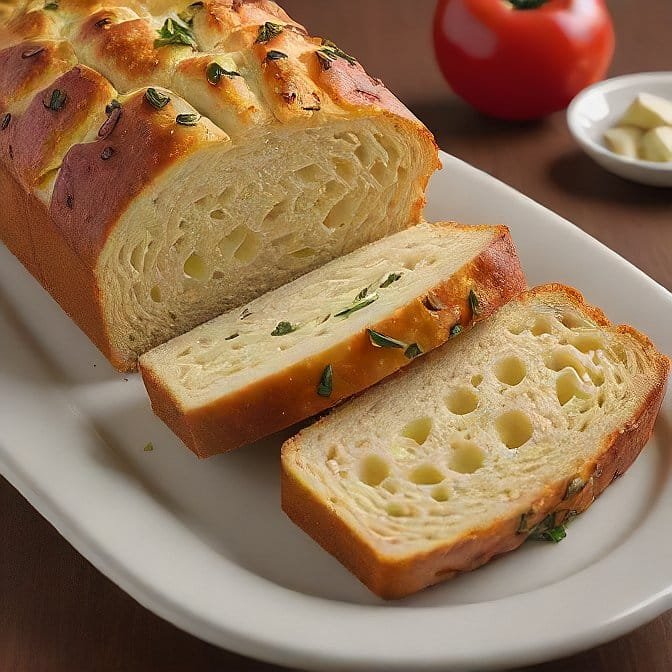Table of Contents
Introduction to Italian Cheese Bread

Pizza bread stuffed with Italian cheese bread has proved to be a sizzling eruptive tasty dish that has engaged the fancy of people all over the world with its soft dough, tasteful cheese, and crispy crust. This hearty bread is best eaten at the start of a meal as an appetizer a mid-morning/mid-afternoon snack, or as the main meal itself. Italian cheese bread is a cross between regular Italian bread and simple cheese bread, and it is highly flexible and can be made to assume certain qualities as preferred by most people.
In this article, we are going to talk about the origin of Italian cheese bread, the types of cheese which is used in it, the process of how to make perfect dough, and some tricks to get a crunchy crust. We shall also look at: ideas for variations, presentation, and wetting kitchen tips as well as common pitfalls to ensure that the Italian cheese bread comes out a success every time.
The History of Italian Cheese Bread
Italian cheese bread also has a rather deep history, and it is closely connected to Italian cuisine. However, bread has been traditionally used in Italian food preparation and hence the addition of cheese to the bread is a result of the normal progression of what was expected to be incorporated in the foods being served to the Italians. This dish has links to all the regions of Italy, where this pasta dish is known with a different variation of the recipe.
For instance, the Liguria region has focaccia di Recco, a kind of cheese bread that originated in the Middle Ages. This is a kind of bread the layers of which are wafer-thin, and the filling used is fresh cheese such as stracchino or crescenza. There are other famous variations, which include the Roman pizza Bianca, which majorly uses mozzarella and other cheeses.
As pastry cheese bread changed centuries ago, people used their regional cheeses and ways of preparation. Today, Italian cheese bread has evolved into conventional cheese bread, which is a cheese-topped bread or stuffed bread that boasts fillings.
Types of Cheese Used in Italian Cheese Bread
Here are some of the most popular cheeses used in this dish:
- Mozzarella: It makes a sticky and elastic mass which is very much appreciated by millions of people.
- Parmesan: Parmesan gives the bread a sharp, nutty taste that goes well with the bread. It can also be sprinkled over the dough to give a food a golden brown, crispy topping.
- Pecorino Romano: Pecorino Romano which originated from sheep’s milk is enriched in salty and sharp taste which enhances the bread. Besides, it is often combined with other cheeses.
- Gorgonzola: If you want to go a little further in taste, the option of Gorgonzola is perfect. This particular is a blue cheese that comes with an aggressive creamy flavor profile and can easily complement many herbs and spices as well.
- Ricotta: The creamery product that is coupled with ricotta cheese is utilized in the making of Italian cheese bread that is stuffed with the creamy sweet paste that counterbalances the bread-like dough.
- Provolone: Provolone is a semi-soft cheese with a rather sharp and pungent taste. It melts perfectly and is suitable for both, the dough and as a topping.
Tips for Making the Perfect Dough
The key to every good Italian cheese bread then is the dough, of which I used a basic recipe that included the following ingredients.
- Measure Ingredients Precisely: The next great thing about baking is that it is chemistry, so ensure you use the right measurements for all your ingredients. For the most accurate results, it is advisable to use the kitchen scale.
- Knead the Dough Properly: This process of kneading in addition helps in the development of the gluten that must be present in the dough if one has to experience the chewy experience. Mix until the ingredients are well incorporated and the dough is soft and pliable, usually for about 10 minutes on hand and 5 minutes or until the dough is elastic, in a stand mixer.
- Let the Dough Rise: The dough has to rise until it has doubled in size; this may take anything between one and two hours, depending on the kind of kitchen. This step is important for a ‘footlight’, as the British bakers call it – bread that is light as a feather.
- Don’t Rush the Fermentation: To get even more flavor out of the dough, you should let the dough ferment in the refrigerator overnight. This slow process assists in developing the character of the dough’s taste and texture.
- Punch Down the Dough: Following the initial rise, use your fist to knock down the dough to drain out gasses before depending on it.
Check Out: Italian Bread: Tips on Things to Avoid When Baking.
Techniques for Achieving a Crispy Crust
Another indication of good Italian cheese bread is the crisp outer skin.
- Use a Pizza Stone: These tools assist in spreading the heat evenly, hence providing the crust with a crispy appearance. Put the stone or steel in the oven as the oven gets warm.
- Steam the Oven: They also put steam during the first part of the baking process to help achieve a crusty crust. Some people accomplish this by putting a pan of water into the oven, others use a water spray and spray water inside the oven before baking.
- Brush with Olive Oil: Some level of a greasy surface can also be applied on the dough through rubbed olive oil for improvement of crispiness and taste.
- Bake at High Heat Initially: To reform the crust so that the bread becomes crispy, one needs to bake the bread at very high temperatures before reducing the temperature slightly so that the inside becomes cooked completely.
- Cool on a Wire Rack: When it is done, take it out from the oven.
Serving Suggestions and Pairing

- With Soup or Salad: For a wholesome dining experience, eat the bread with a serving of minestrone or a green Caesar salad.
- As a Side Dish: Main dishes such as lasagna, spaghetti Bolognese, etc., go very well when served along with this Italian cheese bread.
- Breakfast Option: The bread can be topped with cooked scrambled eggs and a little amount of Parmesan cheese as desired to make a perfect breakfast meal
Troubleshooting Common Issues
Sometimes no matter how much you try, nothing goes right, as much as it is easy to make Italian cheese bread. Here are some common issues and how to fix them.
- Cheese Leaked Out: In case you are making a stuffed cheese pizza, make sure you properly encase the cheese so that it does not leak out during the cooking process.
- The bottom is Soggy: A soggy bottom can be the result of not cooling the bread on some wire rack or, maybe, a baking sheet was used instead of a pizza stone. It is best to cool the bread on a wire rack, and you may want to use a stone for even heating.
Conclusion
Every once in a while there are those dishes that are created with the most basic of ingredients which, when combined, yield a proper taste sensation, and that my friends is where Italian cheese bread most definitely resides. Whether one chooses to work on a standard recipe or try out a new variation, the result is always quite appetizing and satisfying.
Perfectly chewy dough melted cheese, and crispy crust, Italian cheese bread is incredibly popular among households all over the world. By following the tips and techniques outlined above in this article, you will be able to bake the popular bread at home.
Learning how to prepare Italian cheese bread can therefore not just be about recipes, but it has to do with realizing what makes this food unique. Even the selection of the right cheese up to the dough and obtaining the right crust, every step contributes to the pizza.
For More Info: Click Here!
FAQs
Can I use all-purpose flour instead of bread flour?
Yes, you can use any other flour instead of bread flour.



